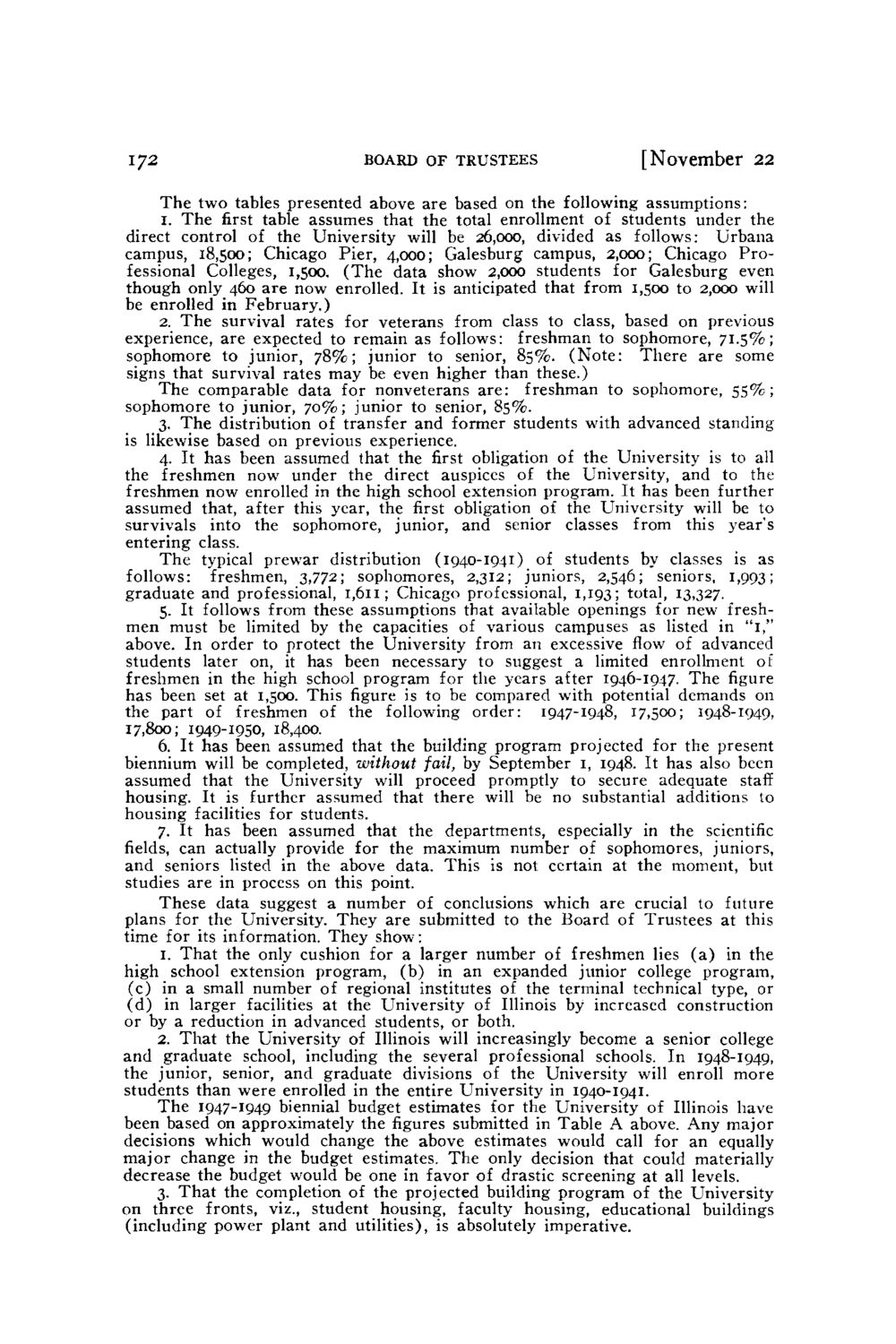| |
| |
Caption: Board of Trustees Minutes - 1948
This is a reduced-resolution page image for fast online browsing.

EXTRACTED TEXT FROM PAGE:
172 BOARD OF TRUSTEES [November 22 T h e two tables presented above are based on the following assumptions: 1. The first table assumes that the total enrollment of students under the direct control of the University will be 26,000, divided as follows: Urbana campus, 18,500; Chicago Pier, 4,000; Galesburg campus, 2,000; Chicago P r o fessional Colleges, 1,500. ( T h e data show 2,000 students for Galesburg even though only 460 are now enrolled. It is anticipated that from 1,500 to 2,000 will be enrolled in February.) 2. T h e survival rates for veterans from class to class, based on previous experience, are expected to remain as follows: freshman to sophomore, 71.5%; sophomore to junior, 7 8 % ; junior to senior, 85%. ( N o t e : There are some signs that survival rates may be even higher than these.) The comparable data for nonveterans are: freshman to sophomore, 5 5 % ; sophomore to junior, 7 0 % ; junior to senior, 85%. 3. T h e distribution of transfer and former students with advanced standing is likewise based on previous experience. 4. It has been assumed that the first obligation of the University is to all the freshmen now under the direct auspices of the University, and to the freshmen now enrolled in the high school extension program. It has been further assumed that, after this year, the first obligation of the University will be to survivals into the sophomore, junior, and senior classes from this year's entering class. T h e typical prewar distribution (1940-1941) of students by classes is as follows: freshmen, 3,772; sophomores, 2,312; juniors, 2,546; seniors, 1,993; graduate and professional, 1,611; Chicago professional, 1,193; total, 13,327. 5. It follows from these assumptions that available openings for new freshmen must be limited by the capacities of various campuses as listed in " 1 , " above. In order to protect the University from an excessive flow of advanced students later on, it has been necessary to suggest a limited enrollment of freshmen in the high school program for the years after 1946-1947. T h e figure has been set at 1,500. This figure is to be compared with potential demands on the part of freshmen of the following order: 1947-1948, 17,500; 1948-1949, 17,800; I949-1950, 18,400. 6. It has been assumed that the building program projected for the present biennium will be completed, without fail, by September 1, 1948. It has also been assumed that the University will proceed promptly to secure adequate staff housing. It is further assumed that there will be no substantial additions to housing facilities for students. 7. It has been assumed that the departments, especially in the scientific fields, can actually provide for the maximum number of sophomores, juniors, and seniors listed in the above data. This is not certain at the moment, but studies are in process on this point. These data suggest a number of conclusions which are crucial to future plans for the University. They are submitted to the Board of Trustees at this time for its information. They show: 1. That the only cushion for a larger number of freshmen lies ( a ) in the high school extension program, (b) in an expanded junior college program, (c) in a small number of regional institutes of the terminal technical type, or ( d ) in larger facilities at the University of Illinois by increased construction or by a reduction in advanced students, or both. 2. That the University of Illinois will increasingly become a senior college and graduate school, including the several professional schools. In 1948-1949, the junior, senior, and graduate divisions of the University will enroll more students than were enrolled in the entire University in 1940-1941. T h e 1947-1949 biennial budget estimates for the University of Illinois have been based on approximately the figures submitted in Table A above. Any major decisions which would change the above estimates would call for an equally major change in the budget estimates. The only decision that could materially decrease the budget would be one in favor of drastic screening at all levels. 3. T h a t the completion of the projected building program of the University on three fronts, viz., student housing, faculty housing, educational buildings (including power plant and utilities), is absolutely imperative.
| |